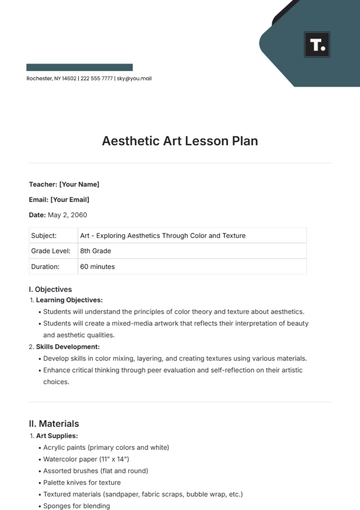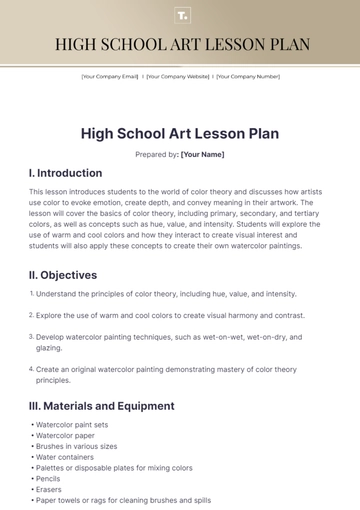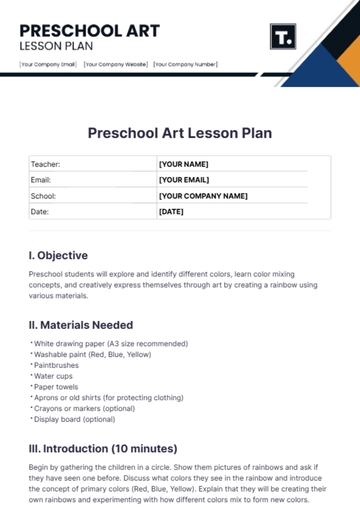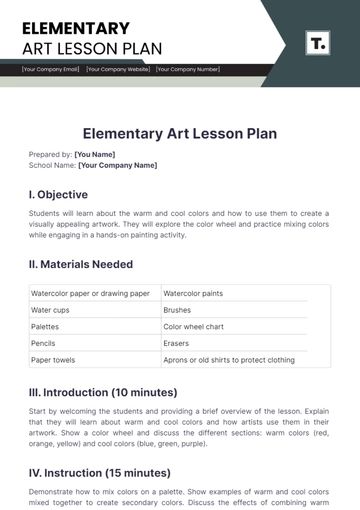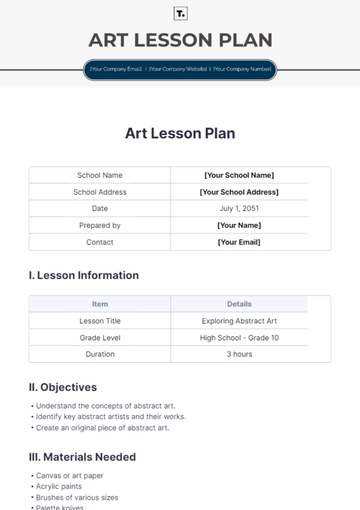Free Aesthetic Art Lesson Plan
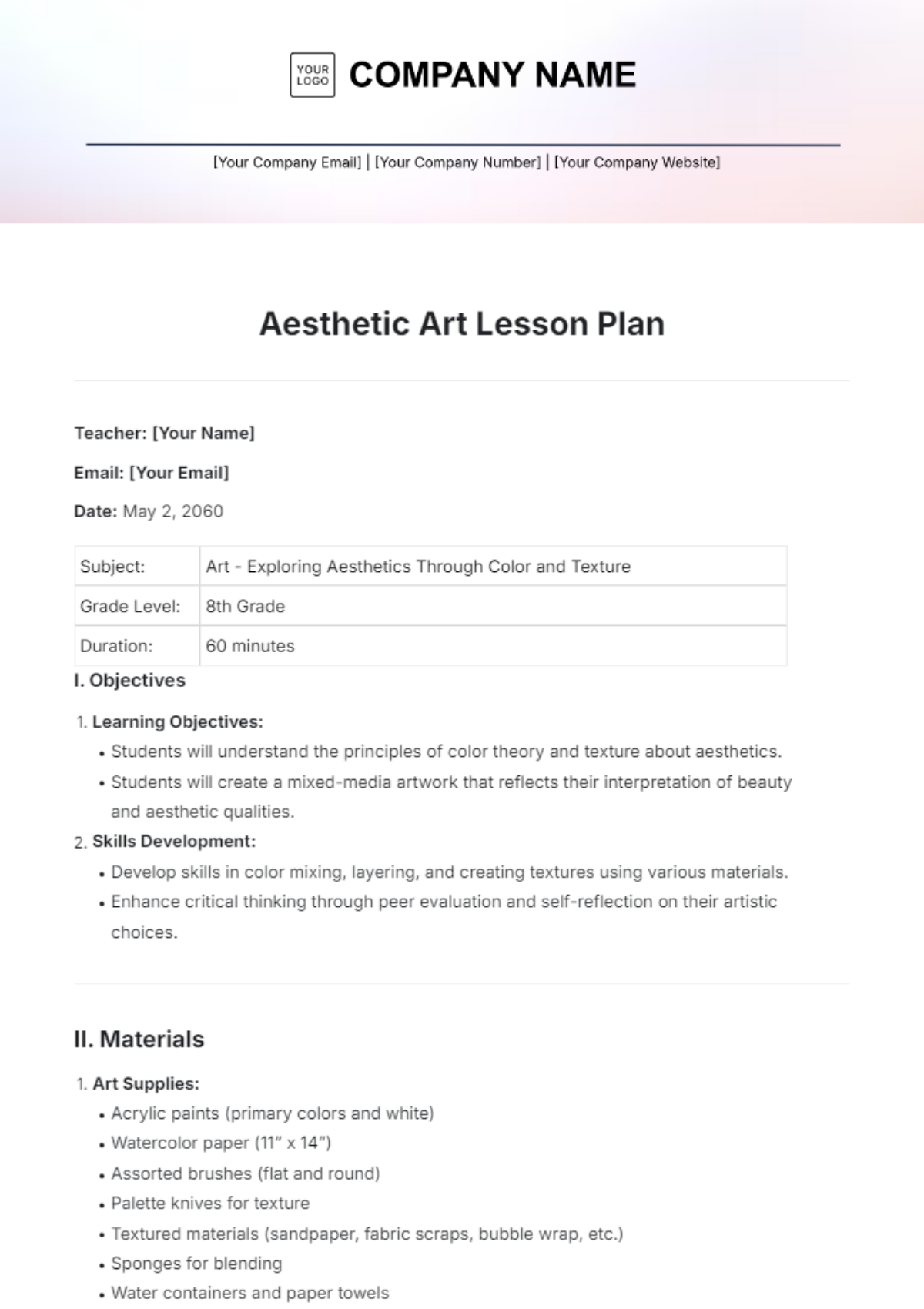
Teacher: [Your Name]
Email: [Your Email]
Date: May 2, 2060
Subject: | Art - Exploring Aesthetics Through Color and Texture |
Grade Level: | 8th Grade |
Duration: | 60 minutes |
I. Objectives
Learning Objectives:
Students will understand the principles of color theory and texture about aesthetics.
Students will create a mixed-media artwork that reflects their interpretation of beauty and aesthetic qualities.
Skills Development:
Develop skills in color mixing, layering, and creating textures using various materials.
Enhance critical thinking through peer evaluation and self-reflection on their artistic choices.
II. Materials
Art Supplies:
Acrylic paints (primary colors and white)
Watercolor paper (11” x 14”)
Assorted brushes (flat and round)
Palette knives for texture
Textured materials (sandpaper, fabric scraps, bubble wrap, etc.)
Sponges for blending
Water containers and paper towels
Resources:
Books: Color: A Natural History of the Palette by Victoria Finlay
Online resources: YouTube tutorials on color mixing and texturing techniques
Visual aids: Prints of works by artists like Claude Monet and Jackson Pollock to discuss aesthetic principles.
Technology (if applicable):
Projector for showing artist examples and video demonstrations.
III. Introduction (10 minutes)
Hook:
Begin with an engaging question: “What colors make you feel happy or calm?” Show a vibrant painting by Claude Monet, asking students how it makes them feel and why. Discuss the concept of aesthetics as the study of beauty and taste.
Objective Overview:
Explain that today, students will explore how color and texture contribute to the beauty of art and create their artworks inspired by these concepts.
IV. Instruction (20 minutes)
Direct Instruction:
Color Theory:
Introduce the color wheel, discussing primary, secondary, and complementary colors.
Explain how warm colors (reds, yellows) can evoke feelings of energy, while cool colors (blues, greens) can create a sense of calm.
Texture:
Discuss how texture can be real (tactile) or implied (visual) and its role in enhancing the aesthetic quality of an artwork.
Show examples of artworks with various textures and discuss their impact.
Demonstration:
Conduct a live demonstration on mixing colors to create secondary colors and how to use texture tools like palette knives and sponges to create visual interest in their artworks.
V. Guided Practice (15 minutes)
Activity:
Students will practice color mixing on their palettes, creating secondary colors, and experimenting with different combinations. They will also create texture samples using the textured materials provided.
Feedback:
Move around the classroom, providing constructive feedback, helping students refine their color mixing, and encouraging experimentation with textures.
VI. Independent Practice (30 minutes)
Artwork Creation:
Students will create their mixed-media artwork on watercolor paper, incorporating at least three colors and two types of textures. Encourage them to think about their interpretations of beauty.
They should plan their composition, considering the use of color harmony and how texture can enhance the overall piece.
VII. Closure (10 minutes)
Class Discussion:
Invite students to share their completed artwork with the class. Encourage them to discuss:
What colors and textures did they choose and why?
How their artwork reflects their aesthetic.
Ask guiding questions like:
How did color choice affect the mood of your artwork?
What texture techniques did you find most effective?
VIII. Assessment
Criteria:
Assess based on creativity, the effective use of color and texture, effort, and participation in discussions.
Use a rubric that includes categories like originality, technique, and presentation.
Reflection:
Have students write a short paragraph reflecting on their artistic process what they learned about aesthetics and their own artistic preferences.
IX. Modifications
For Diverse Learners:
Provide additional support for students who may struggle with color theory, such as using color swatches or visual aids.
Allow students who prefer digital art to create a digital representation of their aesthetic ideas using art software.
- 100% Customizable, free editor
- Access 1 Million+ Templates, photo’s & graphics
- Download or share as a template
- Click and replace photos, graphics, text, backgrounds
- Resize, crop, AI write & more
- Access advanced editor
Inspire creativity with our Aesthetic Art Lesson Plan Template from Template.net. This editable template is designed for customizable art lessons that captivate students' imaginations. With our editable in our Ai Editor Tool, you can easily adjust your plans, making it simple to create visually appealing and engaging art lessons tailored to your classroom needs.
